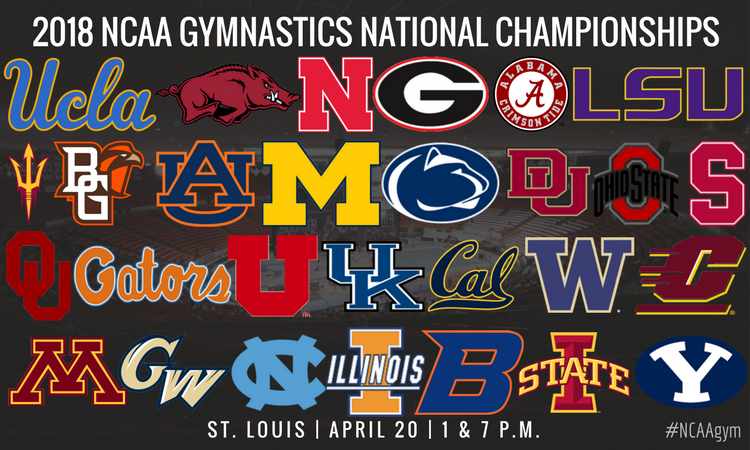After taking a look at how the teams might fare at the NCAA Women’s Collegiate National Championships in St. Louis, it’s time to analyze the individuals. Results from each semifinal will be combined to determine individual event champions, the all around crown and All-Americans on each apparatus. While most contenders are a part of full teams, those individuals that qualified out of regionals also stand a chance at topping the podium Friday night.
All Around
The first semifinal will set the stage for the night session, as it is highlighted by few flashy all arounders. UCLA’s Kyla Ross and LSU’s Sarah Finnegan are the top contenders, holding RQS scores of 39.625 and 39.645, respectively. Fellow Tigers Myia Hambrick and Kennedi Edney could make things interesting as well. All three are ranked in the top 10 nationally. Nebraska’s best chance at an all around placement comes from Megan Schweihofer, but she will need one of her best meets of the season and even that likely won’t be enough.
Alabama hasn’t had a consistent all arounder for most of the season, but Lexi Graber broke out in recent weeks, hitting 39.600 at the SEC championship. However, her average and high are lower than that of her competitors. Expect to see Georgia’s Sydney Snead and Rachel Dickson in this middle tier of contenders. The most likely individuals looking to make a splash are Cairo Leonard-Baker of Arizona State and Denver’s Lynnzee Brown. Brown was out for a good chunk of the season with an ankle injury, only just adding back floor at regionals. Neither will likely challenge for the title, but a finish in the top 10 isn’t inconceivable.
By the second semifinal, the bar will be set as the top competitors take the floor. Oklahoma’s Maggie Nichols, Utah’s Mykayla Skinner and Stanford’s Elizabeth Price will expect to duke it out for the title as the top three in the country. Nichols leads RQS by a decent margin at 39.830 while Skinner and Price sit at 39.695 and 39.680, respectively. Last year, Nichols had a fall in the semifinals that took her out of the all around running, but it wouldn’t even take that much to allow Skinner or Price to pass her. She can’t allow a single opening if she wants to earn her first national all around title.
Skinner’s potential can be limited by her landings, especially on vault and beam, but if she can keep it under control, her scores can easily be above 9.9 on every apparatus. Arguably the most interesting contender here is Price, as she’ll be trying to pull off a feat not achieved in over 20 years: clinching the all around crown without a team. But if anyone can do it, it’s her—she’s had perfect 10.0s on three of four events, including on bars and floor this year. Her weakness is beam, where she’s only broken 9.900 three times this season and usually hangs out around 9.825. She’ll have to make it one of her better beam nights to have a shot.
Florida also brings two strong all arounders in Alex McMurtry and Alicia Boren, with Boren’s RQS ranking her No. 9 in the nation and McMurtry being the defending champion. Boren has been a rock for the Gators in a year where inconsistent has struck more often than not. So if she does her job while others falter, don’t be surprised when the name Boren appears on the leaderboard. We know by now never to count out McMurtry because despite her inconsistencies on beam and floor this season, she is the only other competitor besides Nichols to have perfect 10s on every event. As long as she can tumble, she’s a threat.
MaKenna Merrell-Giles is a dark horse here, often playing second fiddle to Skinner but has eclipsed the Olympic alternate’s totals multiple times. Anastasia Webb finds herself in a similar situation at OU, coming in behind Nichols on most occasions. Both could contend, but it would take some mishaps from lots of other competitors for either to take the title. Toni-Ann Williams and Kyana George will be the top all arounders from Cal, though a lot of people would have to have bad days to get them into the picture, as is the case with Hailey Burleson, Washington’s top all arounder, and Alex Hyland and Mollie Korth of Kentucky. Lexy Ramler and Shani Remme are two individuals ranked in the top 15, but they’ll be at even more of a disadvantage without the rest of their team in St. Louis. Still, crazier things have happened.
Vault
The top vault contenders in the first semifinal are Nebraska’s Sienna Crouse, along with Hambrick and Edney and Alabama’s Nickie Guerrero, who all perform Yurchenko 1.5s. Crouse holds the highest RQS of the bunch at 9.920, but all four have qualifying scores over 9.900. Ross performs a stickable full that can go 9.900 or above more often than not, so if any of the top vaulters falter, she could end up near the top. Auburn’s Drew Watson could factor in on the event as well, with an RQS of 9.885. But she tends to have inconsistent landings. Individual Jovannah East of Bowling Green and Finnegan share Watson’s RQS, with Snead and Edwards .005 behind for their Yurchenko 1.5s. For the individuals, Denver’s Brown and Penn State’s Lauren Bridgens are the top competitors. Brown has a dynamic Yurchenko 1.5 while Bridgens upgraded to that same vault, albeit with some consistency issues.
As in the all around title hunt, the top contenders on vault are all in the second semifinal as it boasts the top six in the country: Nichols, McMurtry, Brenna Dowell, Price, Skinner and Merrell-Giles. Only five hundredths of a point separate their RQSs, so it will likely come down to who has the best landing and air form on the day. There’s also a strong supporting crew in this semi—Rachel Slocum, Mollie Korth and AJ Jackson are all ranked in the top 15 and sport 10.0 starts. The major non-Price individual qualifier who poses a threat here is Cami Drouin-Allaire of GW, who ties Slocum and Korth for No. 10 with an RQS of 9.910. She’s capable of a Yurchenko double, and with a solid landing, could be the surprise of the event.
Bars
Of those competing, the top 10 gymnasts on bars are relatively evenly split between the two semifinals. In the first session, Sarah Finnegan and Kyla Ross are tied with session two competitors McMurtry and Price for the top ranking and RQS of 9.960. UCLA’s Peng-Peng Lee isn’t too far behind (9.940). Crouse, Alabama’s Kiana Winston and Edney could factor in as well, as all boast RQSs between 9.915 and 9.920. Michigan’s Brianna Brown will also challenge, and don’t forget Bridgens picked up a perfect 10 on the event earlier this season.
The second session features Price and McMurtry, as well as the OU duo of Nichols and Nicole Lehrmann. All of these gymnasts have had perfect scores in their careers. Despite being known more for the power events, Skinner is ranked No. 10 on bars, putting her in a prime position to sneak into the picture with a big routine. Other potential contenders in this second semi include Ramler, Dowell and Korth. Shannon Hortman Evans of BYU qualified as an individual for bars, but with a 9.890 RQS and only one score higher than a 9.900 all season, she’s going to have a harder time challenging that top tier of competitors.
Beam
UCLA’s Lee leads the way on beam in session one, and her 9.985 RQS tops the overall rankings as well. Teammates Katelyn Ohashi and Grace Glenn also could challenge on beam, with a 9.945 and 9.925 RQS, respectively, but Glenn may have a harder time as the Bruins’ leadoff on the apparatus. Finnegan and Guerrero excel as well; each ranks between Ohashi and Glenn in the RQS rankings. Hambrick also shares that RQS of 9.925 while Ross’ beam work earned her a 9.910 RQS. Individual Abby Milliet shines on beam, the only event she qualified to nationals on. Her exquisite work will challenge the best, but it won’t be easy. With so many strong competitors in this session alone and the separation between gymnasts so small, this should be one of the most interesting event titles to watch for.
With many of the strongest beam competitors in the first session, expect to see Nichols as the star of session two with multiple Gators also capable of challenging her. Nichols is ranked No. 2, but McMurtry, Boren and Alyssa Baumann all rank within the top 10, and Rachel Gowey is close behind at No. 14. Only seven hundredths separate Nichols’s RQS from Gowey’s, so it could come down to the wire. Not to be forgotten, Skinner’s RQS ties her with Gowey, so expect to see her in the race as well, especially if she manages to stick her double tuck dismount. Oklahoma will also bring more to the table than just Nichols—Webb, Brehanna Showers and Stefani Catour can all go 9.900 or better on a regular basis, and Webb earned a perfect 10.0 earlier this season. Washington is also a formidable beam team, with Burleson, Evanni Roberson and Joslyn Goings their standouts. And though they struggled at regionals, beam is normally a strength for Kentucky, with Hyland as the highlight of the lineup. Individual qualifiers Ramler, Morgan Lane and Shani Remme are all strong beam performers as well, and on their best days, they can contend with the top tier girls. Without their teams, though, it may be harder to have their best days or to be recognized for them when they do.
Floor
Two gymnasts in semifinal one share the No. 1 ranking on floor: Hambrick and Ohashi at a 9.970 RQS. However, note that Hambrick has been off her game in three of her last five routines. Whether she’s found her spark again will tell us a lot about her chances. Finnegan, Hano and Schweihofer also excel here, but their shared RQS of 9.935 is quite a bit lower than that of the top two. Edney’s powerful routine ranks her just below that, and Guerrero, Winston and Georgia’s Sabrina Vega could factor in as well. But the gap between the RQS scores over 9.900 and the top scores is the largest of the four events, so it will be tough to break into the top spot. This is true for Leonard-Baker, too, who also has an RQS over 9.900 but lags considerably behind the top spot despite having a dynamic, well executed routine. A dark horse here is Denver’s Brown. She returned to the floor lineup at regionals with her double layout and all. And she didn’t just return but returned with a bang, scoring a 9.950. With a performance like that, she could certainly challenge for the floor title.
Once again, Nichols, Skinner and Price are the top contenders, all tied for No. 3 in RQS. They’re only a hair behind Hambrick and Ohashi out of the first semifinal, so don’t be surprised to see one (or all) of them finish ahead. Watch Skinner and Price in particular, as they will be the last two performers on the event in the entire competition. If that doesn’t scream “give me a 10 when I hit this,” what does? Other strong contenders include Merrell-Giles, Cal’s Williams, Boren and McMurtry. All can go 9.950, giving them a strong case to at least tie for the title. The next tier showcases the Sooners again, with Webb and Dowell putting their best foot forward, along with individual qualifiers Remme and Drouin-Allaire.
Want to receive the latest collegiate gymnastics news in your inbox? Sign up for the NCAA Gym NewsLetter here.
Article by Caroline Medley and Tara Graeve




